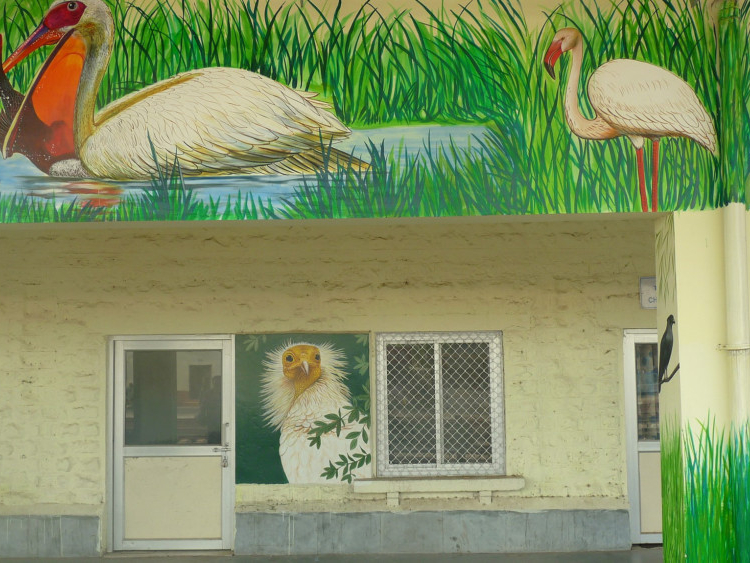
In India, 23 million people travel on the railways every day, and the stations are full of life. The poorer passengers don’t just pass through the stations - they sleep in them, cook meals on kerosene stoves, eat and wash on the platforms as they wait for unconscionably delayed trains. As a result, many Indian stations have become a microcosm of the squalor that afflicts much of the urban landscape.
But all that is changing. There are now 80 stations (and some metro stations) across India where every throbs with colour and imagery. Indians who would normally never enter an art gallery now encounter new art by local artists or traditional art forms that had been threatened with extinction on a daily basis.
The movement began in 2014, when conservationist and tiger expert Valmik Thapar wondered why Sawai Madhopur station, which is close to Ranthambore national park, home of the tiger, couldn’t be decorated with tigers. Why couldn’t people visiting Bharatpur bird sanctuary get off the train to be greeted with murals of birds? Why couldn’t the station at Bhubaneshwar, known for its crocodiles and Buddhist statues, reflect this heritage?
Thapar contacted railway officials and, with the help of the World Wildlife Fund, the stations began to change. Tiger eyes now follow you through Sawai Madhopur station. With a few brushstrokes, a decrepit dump has become an open air, public art museum.
“I’ve been visiting Ranthambore for 30 years. The gorgeous artwork is the best thing that’s happened to the town,” says Hema Maira, a retired teacher from New Delhi who frequently travels to see the tigers. “The pictures capture the essence of the park and its most famous denizens.”
The railways project is part of a wider street-art revolution instigated, in 2014, by a Mumbai group called St+art India Foundation that has transformed the old Sassoon Docks in Mumbai and the Lodhi Colony neighbourhood in New Delhi into the country’s first public art district. (Brigitte Macron, wife of the French president, made a point of touring it during a visit in March.)
“What we have been attempting to achieve is a freedom meant not just for the artists, who stand to gain a wider canvas, but also for those who would be able to appreciate art they might never have had access to otherwise,” says St+art co-founder and creative director Hanif Kureshi.
Ordinary people are often shocked by the size and scale of the murals, which include a massive image of Mahatma Gandhi on the facade of Churchgate station in Mumbai. “They think it’s an ad and some fool forgot to put the company logo on it,” says Kureshi.
Mumbai has one of the densest suburban networks in the world, with more than 7 million daily passengers, and 36 stations in the city have been given a makeover. In October, two NGOs, Mumbai First and Making a Difference, roped in 25,000 volunteers and artists from art schools to paint for seven days, with materials provided by paint companies.
Rajiv Choudhury, Indian Railways’ station development director, says that about 80 of the country’s 3,000 or more stations have now been spruced up in this fashion. “It is up to the local communities around the remaining ones to paint those too if they wish.”
And across India, dying art forms have been revived. A technique known as phad - paintings on cloth depicting stories of local deities, with every inch densely covered - is all over Jodhpur station. Udaipur City station has revived images from the Mewar School of Art, an important school of miniature painting in the 17th and 18th centuries. Jaipur station has been painted with Jogi art, a tribal form that uses dots and lines. Ajmer showcases the calligraphy for which the city’s craftsmen are famous. At Madhubani railway station in Bihar (which used to be one of the dirtiest in India), tourists go to see the traditional Mithila scenes from mythological texts and folklore that now cover almost every inch of the building. As the craze spreads, local artists are now getting work from the owners of cafes and offices who feel that one brightly painted wall might be just what they need.
In fact, an unexpected result of the project is that the painted walls have drastically reduced the amount of littering and spitting. “People are reluctant to damage something nice,” says Choudhury.
Veena Joshi, a marketing executive in Mumbai who travels by rail to work every day, said that Indians are starved of nice surroundings; 60% of Mumbai’s population, for example, lives in slums. “The moment I see the colours at Khar, it lifts –Guardian News & Media Ltd














